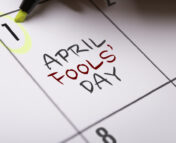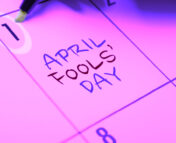Astronomy has a great tradition of April Fools day papers. Scientists in the field with a sense of humor and some extra time often think of a silly science experiment and then post it to the official preprint archive for the 1st of April. These papers are meant to be a lighthearted send up of the field, using current techniques on unusual subject matter, poking fun at aspects of the field, or just an excuse to have a laugh. They are not intended to be taken seriously, and there is no formal peer review process.
Until we started doing it. (2023, 2022)
To add to the fun, and to highlight all the great work that has gone into each paper, here are our reviewer comments on the 17 April fools days papers in 2024.
Authors: Patricio E. Cubillos
First author affiliation: Space Resort Institute, Graz, Austria
Paper Title: The Public Photometry Pipelines for Exoplanets
Dear Dr. Cubillos,
Your paper, and its associated open-source software PUPPIES aims to “improve the quality of research-life for astronomers,” and we believe it will succeed in this mission. It will provide its (sure to be large) user base a method to generate a “Dog of the Day,” add pup markers in plots, and even to analyse exoplanet spectra.
Reviewer 1
The minute I saw this package I dropped everything to install it on my computer. All of my plots will now be made with “pup” markers. Is this package cross-compatible with the pastamarkers package, when I need another marker type?
Reviewer 2
The idea to have a “Dog of the Day” is cute and all, but I’m allergic to dogs. When is there going to be a hypoallergenic version of this package?
Note from the editor: On a serious note, we commend the author of this paper for the well-written disclaimer at the end of this paper, addressing the serious and debilitating issue of mental health and harassment.
Authors: J. Fowler & Ruth Murray-Clay
First author affiliation: University of California, Santa Cruz
Dear (Future) Dr. Fowler and Dr. Murray-Clay,
With the forthcoming JUICE and Europa Clipper missions and the exoplanet people taking up JWST time, detailed studies of our future interactions with extraterrestrial life in and out of our solar system are essential. Thank you for your work using the REBOUND code to expose the ring-puffing caused by the USS Voyager‘s presence in orbit around a Neptune-like planet. The questions asked herein about the interference of starships entering the solar systems of pre-warp societies may inform future series of Star Trek and eventual Federation policy.
Reviewer 1
This paper is rigorous in its assumptions of initial system parameters based on the opening credits of Voyager and its use of realistic planetary ring parameters. They take great care to hypothesize the impacts of ring-puffing on existing civilizations, including the xenoanthropological faux-pas of Voyager’s destruction of moon-shadow based religions. This work is easily extensible and applicable to other Trek franchises where captains park around random systems like teenagers learning how to drive in parking lots. Recommend for publication.
Reviewer 2
The author’s work inarguably demonstrates the impact of the presence of Voyager on planetary rings. However, parking in an atmosphere is nothing compared to their larger violations of the Prime Directive, including giving the Hirogen holodecks which led to the events in Flesh and Blood, dooming the Ocampa by destroying the Caretaker’s technology (Caretaker Part II), and whatever nightmarish astrobiological implications came out of Janeway and Paris’s weird lizard children in Threshold. Additionally, the Krenim Imperium had been messing with the timeline in the area for the past 200 years (Year of Hell), so the cultural impact of the moon shadows changing may not be as severe as the authors project.
Authors: Stephen M. Wilkins, Sophie L. Newman, Will J. Roper
First author affiliation: Astronomy Centre, University of Sussex
Paper Title: FOOD I: A New Division Scheme for the Stelliferous Era
Dear Dr. Wilkins,
The lack of standardized nomenclature for the divisions of cosmic eras has, up until now, been a grave oversight in the field of astronomy, and your work represents a valuable breath of fresh air. For too long have we as a field labored under the yoke of inconsistent, confusing, and poorly defined buzzwords like “high redshift” and “cosmic dawn”, which sound exciting on grant proposals but lack any real scientific validity. Your paper rectifies this admirably while retaining the advantages of the current nomenclature for grant applications, and we at the Journal of Incorrect Astrophysics are happy to recommend it for publication.
Reviewer 1
I am very impressed with this paper. It is not nearly often enough that we, as astronomers, acknowledge the contributions of Tolkien et. al. to the science of astronomy. The fact that these authors do so shows an impressive depth of research and familiarity with the field. In addition, as an astronomer, I wholeheartedly agree with the authors that cosmologists should be put in their place. A Universe without stars, galaxies, or metals is functionally irrelevant to modern high-redshift astronomy, and while I suppose they can study it if they want, they should not be allowed to take my grant money to study things like “B-fields”. Whatever those are.
Reviewer 2
As a cosmologist, I find the proposed division between “exceptionally” and “ludicrously” high redshift to be lacking in scientific value; would it not be a better idea to mark the division at z = 1100, the approximate redshift of the CMB, and add an additional, say “normal” high redshift at the epoch of inflation z = 1025 for further granularity? Furthermore, while the authors do propose a scheme for altering the FOOD nomenclature to apply to those from Northern England, they fail to meaningfully account for differences in the times at which the same meal is taken across cultures, socioeconomic classes, and time periods. For example, my roommate eats dinner at around 8 pm, while my parents eat at 5:30, and I eat when I remember to. I suggest the authors expand their analysis to include these effects, with the end goal of creating a fully realized FOOD framework for each individual on Earth.
Authors: Merlin Füllgraf, Jochen Gemmer
First author affiliation: Institute for Physics, University Osnabrück, 49076 Osnabrück
Paper Title: Maximum Expected Reward Line If Non Specialist – Law (for darts)
Dear Dr. Fullgraf,
Throwing darts is fun, yet it can frequently lead to frustration. In this seminal work, you have meticulously illustrated strategies for optimizing dart throws. By following your prescribed maximum expected reward lines, I am confident that any beginner can significantly enhance their scoring potential in darts.
Reviewer 1
The idea of modeling the spread of dart throws with normal distributions is truly ingenious. This work caters to both seasoned players, illustrated by the isotropic spread case, and novices who exhibit unequal horizontal and vertical spreads. I recall losing a bet during a game of darts while aiming for the bullseye. This paper promises to finally refine my dart-throwing skills, ensuring I no longer lose such bets in the future.
Reviewer 2
After reading this paper, I went to a local bar with some of my friends to play some darts. I didn’t fancy a game though so I did a 180 and left.
Authors: P. Flock, A. Laguna-Salina, F. James, G. Blossom, B. Carotene, C. Sparks, D. Tarek, A. Ahashia and J. Donald,
First author affiliation: Flamingo International College, Indonesia
Paper Title: Why FLAMINGO is the perfect name for an array of Cherenkov telescopes

Dear Dr. Flock, Dr. Laguna-Salina, Dr. James, Dr. Blossom, Dr. Carotene, Dr. Sparks, Dr. Tarek, Dr. Ahashia and Dr. Donald
We want to thank you for your surprising albeit enlightening work on the naming of a new array of Cherenkov Telescopes. It is pleasing to see such a detailed effort is made to put up some good names in Astronomy for once. One would be forgiven to believe that the “Fast Light Atmospheric Monitoring and Imaging Novel Gamma-ray Observatory” (FLAMINGO) is where the famous pink birds got their name from.
Reviewer 1
Is there a way to claim copyright on this before the authors do? Does it fall under plagiarism if I make money on this? Should I get a lawyer?
Reviewer 2
Somehow, the authors managed to connect the nomenclature for an array of Cherenkov Telescopes with the, admittedly visually pleasing, color pink and the iconic flamingo bird species. On first thought, this would fall right under the wing (pun intended) of spurious associations, but somehow it makes actual sense. It’s all connected, it’s all part of the plan. COINCIDENCE, I THINK NOT *hack cough*
In addition, the authors have managed to pull one off in a manner hitherto undreamt of: getting the word ‘flamingo’ in an Astronomy related work significantly more than in a paper on actual flamingos. Most impressive. To finalize, the pink, nay, flamingo-colored references in the paper really help getting the author’s point across.
Authors: Mark Popinchalk
First author affiliation: American Museum of Natural History, New York
Paper Title: Species Syzygy: Which Animal Has Seen the Most Total Solar Eclipses?
Dear Dr. Popinchalk,
We are pleased to accept your paper, exploring the significance of the total solar eclipse beyond the human experience. It is a commendable contribution to the fields of astronomy, biology, paleontology, and horseshoecrabology. The AWESOME time metric is sure to become an essential staple for those working in these cross disciplinary fields as well as an inspiration for astronomers everywhere to continue using whatever letters you want out of words when making acronyms.
Reviewer 1
The meticulously crafted framework that delves into calculating the number of Total Solar Eclipses (TSEs) witnessed by various species over geological timescales offers a unique perspective on the interaction between celestial events and the animal kingdom. The paper’s takes careful consideration for not only geometric projection issues of the path of totality but also the habitat. This paper will no doubt spur on science communication efforts around eclipse attendance, as we do need to catch up to the horseshoe crabs, as well as astrobiological studies of the rapidly growing exoplanet population.
Reviewer 2
The paper’s reliance on speculative scenarios, such as predicting the future TSE experiences of species based on current population trends, introduces a high degree of uncertainty and conjecture into the analysis. The extrapolation of data over millions of years, especially regarding population levels and evolutionary trajectories, lacks empirical support and may lead to misleading or unsubstantiated conclusions. For example, what about the role of shrimp colors in observing TSEs? The author also does not consider the role of major impact events, which likely decreased the number of dinosaur TSE observations due to debris sky coverage.
Authors: Michael B Lund
First author affiliation: Caltech/IPAC-NExScI
Paper Title: Vulcan: Retreading a Tired Hypothesis with the 2024 Total Solar Eclipse
Dear Dr. Lund,
We must start by commending you on yet another contribution to the literature, your previous works have been well received. This article is no different. You present a delightful true history of the science of astronomy detailing the process through which the planet Vulcan was expected, “detected”, debated, and ultimately dismissed. Then, using the theoretical advances since, you offer a call to action to search once again for the potential of Vulcan’s first true detection during the 2024 Total Solar Eclipse.
Reviewer 1
The historical context in section 2 is a well-written and wonderful story about Vulcan, the planet that wasn’t. While many of the articles submitted today are focused on exploring new avenues, returning to well-meaning but ultimately dismissed theories with lighthearted aspirations to make them plausible is a refreshing take. Your understanding of astronomy history and playful extension of it into possible observations of today shines through the piece.
Reviewer 2
This is a dangerous article! What if we find it! We’d have to redo all the mnemonics for learning the planets. AGAIN. The public is still talking about Pluto, we’d never let it down. I suggest we all close our eyes on April 8th, just to make sure we don’t accidentally see the planet that isn’t there.
Authors: PASTA Collaboration, N. Borghi, E. Ceccarelli , A. Della Croce, L. Leuzzi, L. Rosignoli, and A. Traina
First author affiliation: University of Bologna
Paper Title: pastamarkers: astrophysical data visualization with pasta-like
Dear Dr. Borghi,
Congratulations on the acceptance of your paper, which introduces the intriguing concept of pastamarkers for astrophysical data visualization. The PASTA Collaboration’s endeavour to enhance the representation of astrophysical data is indeed commendable in this age of petabyte astronomy. The development of the pastamarkers package reflects innovative thinking and meticulous attention to detail, potentially offering a captivating and memorable approach to visualizing complex astrophysical phenomena.
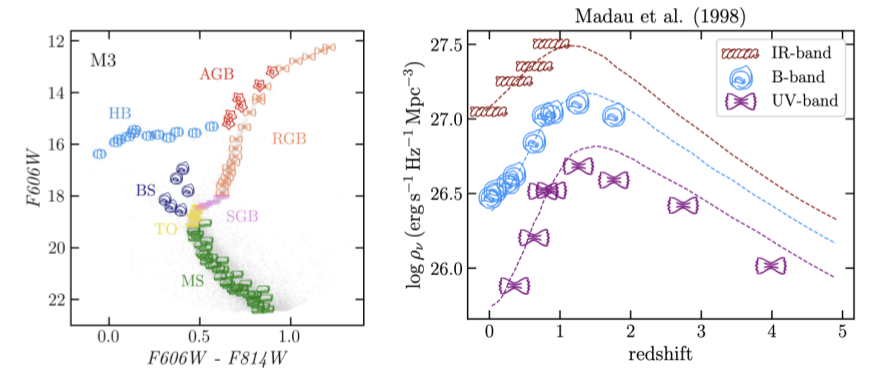
Reviewer 1
The use of unique pasta shapes as markers in astrophysical plots could provide benefits beyond mere novelty. Colour-blind astronomers, often faced with challenges in interpreting data visualization reliant on colour distinctions, could find solace in the distinct shapes of pasta markers, allowing for improved accessibility and understanding. Furthermore, the potential for engaging the public in the wonders of astrophysics through pasta-themed visualizations is not to be overlooked. This unconventional approach has the potential to not only make astrophysical concepts more digestible but also to increase appetite. I look forward to further implementations of the code to cook up fantastic astrophysics!
Reviewer 2
While the concept of using pasta shapes as markers in astrophysical plots is undeniably unique, I must express my scepticism regarding its practicality and scientific merit. Firstly, let’s address the elephant in the room: pasta al dente. The choice of pasta, while whimsical, seems to overlook the fact that not all astronomers are fond of al dente textures. It’s a slippery slope when you start catering to astronomers’ culinary preferences rather than focusing on the data. Introducing pasta shapes into plots risks shifting the focus from scientific insights to cravings for Italian cuisine. In conclusion, while I appreciate the attempt at innovation, I fear this approach might leave a bad taste in the mouths of serious researchers.
Author: Eve Armstrong
First author affiliation: Department of Physics, New York Institute of Technology; Department of Astrophysics, American Museum of Natural History
Paper Title: Everything’s Fine
Dear Dr. Armstrong,
Thank you very much for your submission, which we are delighted to accept. Mental health in academia has rightly become an increasingly important subject of discussion in recent years. Within that context, this work provides a needed perspective: that of someone who neither wants to change, nor believes that they should. Your description of your own internal experience is both insightful and deeply relatable, and your investigation of why exactly a dinner party might drive you to sprint away at top speed is well-motivated and engagingly written.
Reviewer 1
A well-researched, thorough, and bold paper covering topics outside the purview of most physicists: neurology, epigenetics, and the author’s own psyche. The author is to be commended for her introspection, as well as her restraint in refraining from (provably) committing murder, stealing cattle, or buying a Dell laptop.
Reviewer 2
While the author’s examination of why seemingly innocuous situations drive her to irritation and anxiety is appreciated, I object to her assertion that wearing a dress makes sprinting “tricky”. As a skirt-wearer myself, I can assure any reader that it is more than possible to exit awkward social situations at a dead sprint while wearing skirts, and that I do so with some frequency.
Authors: A. Winter, A. Winter, A. Winter, and A. Winter
First author affiliation: Departament de Física, Universitat Autònoma de Barcelona, Spain
Paper Title: Is Winter Coming?
Dear Dr. Winter,
We thank you for your insightful contributions to the fields of quantum computing, economics, history, medicine, and meteorology, among others. Your paper represents an important step forward in our ability to know for sure whether winter is coming, and presents several groundbreaking conclusions in a concise and rigorous proof.
Reviewer 1
I can find no flaw in the analysis presented by today’s authors, although I admit I was somewhat pressed for time and was not familiar with all of the cited references. I’m sure they’re legitimate, though.
Reviewer 2
I must say I disagree with the conclusions you draw from Winter (2004), as well as from Winter (2019). In fact, several of the works you cite seem to be completely irrelevant to the arguments of the paper, and you fail to cite my the seminal contributions of Winter et. al. (2023a, 2023b, 2024). Please revise so as to include references to these works and prune supercilious citations.
Authors: D. Sidious, S. Arcari, N. Barbieri, L. Bazzanini, L. Caloni, G. Galloni, R. Impavido, M. Lattanzi, M. Lembo, A. Raffaelli, N. Raffuzzi, S. S. Sirletti
First author affiliation: Sith Order, Sith Temple, Moraband, Korriban
Paper Title: Echoes from a long time ago: Chewbacca inflation
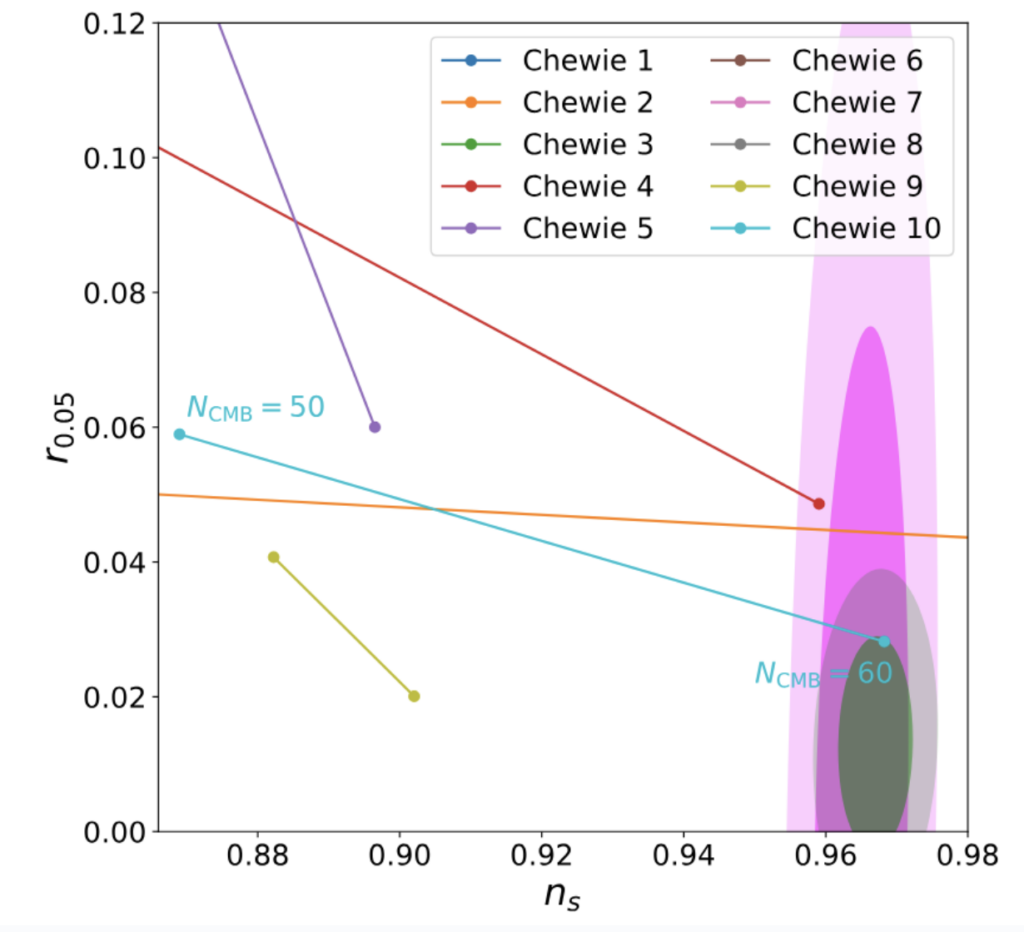
Dear Dr. Sidious (Darth Sidious?)
Your work of utilizing Chewbacca’s iconic screams to investigate primordial acoustic perturbations represents a truly innovative approach in cosmology. In contrast to other inflationary models, your unique model could be the key to finally understanding inflation. With tighter observation constraints, we may pinpoint the precise Chewbacca scream responsible for triggering inflation.
Reviewer 1
The idea of translating Chewbacca’s scream spectrogram into inflationary potential is novel, and I applaud the author’s efforts in sampling Chewie’s screams from the original trilogy. I’m delighted to note Figure 4’s implication that one of Chewie’s screams aligns closely with observations from Planck, BICEP/Keck, and BAO. As a big fan who dresses up as Chewbacca every Halloween, I wholeheartedly endorse this study. The force is strong with this one.
Reviewer 2
I suggest the authors extend their investigation by incorporating other iconic characters from the Star Wars universe, such as the droid R2-D2. A comparative study of R2-D2’s beeps and Chewbacca’s screams to find the best-fitting inflationary model would be interesting. Furthermore, the Chewbacca inflationary models should be extended by including samples of his screams from the sequel trilogy, Star Wars: The Clone Wars, and the Han Solo movie.
Authors: Gwen Walker, Nick Ekanger, R. Andrew Gustafson, Sean Heston
First author affiliation: Dept. of Physics, Virginia Tech
Paper Title: Multi-Messenger Astrology
Dear (Future) Dr. Walker,
We are pleased to accept your paper, with revisions, on the subject of new multi-messenger components of astrology. Your new theory rigorously defines the impact of gamma rays, cosmic rays, neutrinos, and gravitational waves on an individual’s personality. Congratulations on this possibly career-defining piece of research, as this paper is now the second result when one searches “Gwen Walker Virginia Tech”.
Reviewer 1
As an Aquarius sun, Aries Rising, Capricorn Moon, Aquarius Mercury, Pisces Venus, Scorpio Mars, Aries Saturn, Aquarius Neptune, Sagittarius Pluto, this paper made me finally feel seen, and I recommend it for immediate publication. I never before had the explanation for my seemingly erratic decision to attend school for seventeen-plus years, but this groundbreaking work shows that my dearth of gamma rays, the average amount of neutrinos, and the slight uptick in gravitational waves are to blame! I appreciate the bold sincerity of questioning not only the boring questions asked by astronomy researchers but also the low pay rate; your comment on the need for astrological “apartments” in this economy is especially insightful.
Reviewer 2
While a compelling subject, the authors fail to account for several known effects that should be included in a revision. They neglect to include Ophiucus, the thirteenth Zodiac constellation, and, therefore, all people born between November 29 and December 18. Then again, those affected Sagitarrii can get over it. Additionally, in Petroff+ 2015, the origin of FRBs was determined to be people opening microwaves too soon. The authors fail to consider the impatience of hospital staff at the time of birth and its impact on individual development.
Authors: Jonas El Gammal, Sven Günther, Emil Brinch Holm, Andreas Nygaard
First author affiliation: University of Stavanger
Paper Title: Circular reasoning: Solving the Hubble tension with a non-π value of π
Dear (Future) Drs. El Gammal, Günther, Holm, and Nygaard,

With the Hubble Tension becoming one of the premier hot topics in astronomy, a wide variety of solutions have been proposed in recent years. Your work, positing a revision to the value of the fundamental constant π, is elegant in both its simplicity and legality, and we wholeheartedly recommend it for publication with the following comments.
Reviewer 1
An extremely rigorous and well-motivated paper that produces an excellent solution to the Hubble tension. The boldness of the authors in citing a number of papers published at z < 0 is appreciated; in particular their recognition of the sure-to-be valuable contributions of G. P. T. Chat (2024) and God et. al. (4048). Their results are in good agreement with the literature, including the date of the Universal Birthday calculated in Appendix 1, which is only a week away from the Oct 21 date reported by Pratchett & Gaiman (1990), although the actual estimated year of the Universe’s creation diverges by 13,097,249,340 years.
Reviewer 2
I hate how long it took me to figure out why your proof that π = 4 doesn’t actually work.
Authors: Douglas Scott & Ali Frolop
First author affiliation: Dept. of Physics & Astronomy, University of British Columbia, Vancouver, Canada
Paper Title: Deeper Learning in Astronomy
Dear Dr. Scott and Dr. Frolop,
As the unstoppable march of Machine Learning is, perhaps, in need of critical review, we want to express our thanks for your work on this matter. Your clearly unbiased and concise overview on the wonders of Human Learning could very well serve as the fresh alternative the field is yearning for. Nevertheless, as inherently anchored in this work, Human Learning can still only serve as a supplement to the monumental problems present-day Machine Learning topples with great success. Perhaps, in the not so distant future, human-run problem solving of complex tasks may become more common or, should policy allow, even evolve to the standard way of doing things.
Reviewer 1
The authors have not only managed to eloquently summarize the pioneering research on Human Learning (HL) in Astronomy, but have also succeeded in bridging it with the many advantages of the Machine Learning establishment. The paper also comes with a plethora of suggested nomenclature and the accompanying abbreviations for HL that will certainly be used as the de facto standard for many years to come. It almost brings a tear to my eye. Anyways, keep up the good work.
Reviewer 2
The authors manage to bring across an enthusiasm for correct grammar quite uncommon in most of the Astronomy-related published works these days.
Authors: Andrew D. Gow, Peter Clark, Dan Rycanowski
First author affiliation: Institute of Cosmology & Gravitation, University of Portsmouth, Dennis Sciama Building, Burnaby Road, Portsmouth, PO1 3FX, United Kingdom
Paper Title: I’m in AGNi: A new standard for AGN pluralisation
Dear Dr. Gow,
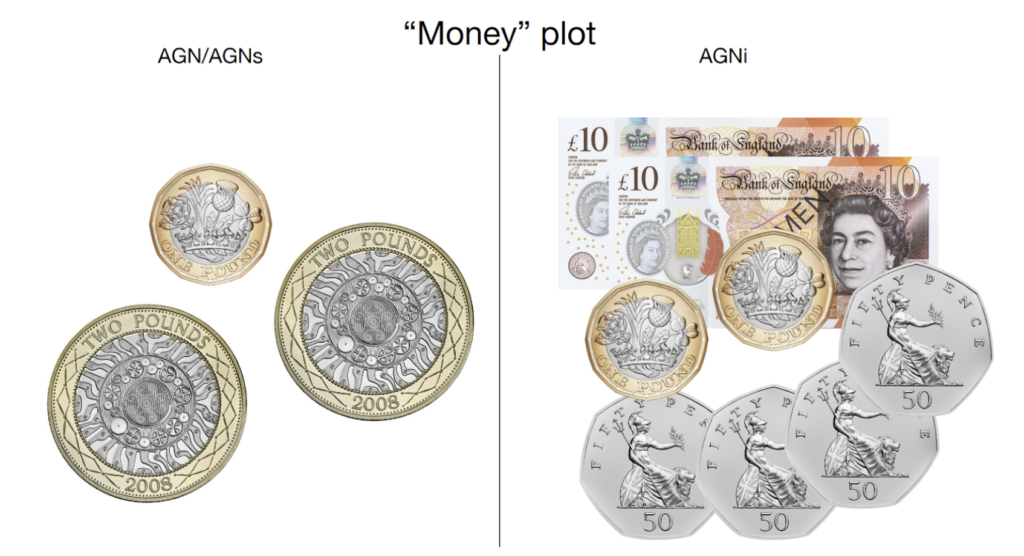
Thank you for your submission of this new standard for Active Galactic Nucleus (AGN) pluralization (AGNi, which can be pronounced as one word like “agony”). This paper addresses the rampant confusion among astronomers on the correct way to pluralize these sources, by setting a clear standard following the Latin root word “nuclei,” as is done in many other source classes.
Reviewer 1
This paper excellently solves this problem, which has put us all in AGNi for far too long. The increase in speaking speed when using this acronym will be a boon to all astronomers’ conference talks, where time is of the essence. This reviewer agrees that the ability to make puns should be an essential consideration in choosing acronyms for common abbreviations, as did 69% of the respondents to the anonymous survey.
Reviewer 2
The illustration of the movement of the field towards the “AGNi” acronym in the money plot shows a clear preference towards this new proposal. Clearly, that is where the money is in future!
Authors: Henrik Viitasaari, Oskari Färdig, Joona H. Siljander, A. Petrus Väisänen, Aapo S. Harju, Antti V. Nurminen, and Jami J. Kinnunen
First author affiliation: Department of Applied Physics, Aalto University School of Science, FI-00076 Aalto, Finland
Paper Title: Unobserving the Moon: the spurious possibility of orbital decoupling due to solar neutrino Arago spot
Dear Dr. Kinnunen,
Thank you for your fascinating work bridging the astronomical scales of “very big” and “very small”, by estimating the potential for measuring the diffraction pattern of solar neutrinos by the Moon during the upcoming total solar eclipse. This is not just a scientific paper, but a public safety one, as your work also considers if such a precise measurement of the Moon’s position could, via the uncertainty principle, create a momentum change in the Moon’s orbit.
Reviewer 1
This paper sets up the de Broglie wavelength and diffraction pattern scenario within exceptionally well. I was filled with suspense throughout, on baited breath to see if indeed the Moon could possibly be “observed out of existence”. The considerations on the spherical imperfections of the moon were the perfect level of detail. I could see this paper being a valuable teaching tool and moment of levity in a quantum 101 class.
Reviewer 2
I wanted to write a review, but every time I tried to accurately observe the article to read it, it got really blurry. Will provide more comments after my eye exam.
Authors: Earl Patrick Bellinger, Jakob Stegmann, and Tom Wagg
First author affiliation: Department of Astronomy, Yale University, CT, USA
Paper Title: Stupendously Large Black Hole Coalescence and Hubble Tensions
Dear Dr. Bellinger,
Thank you for your work attempting to resolve the Hubble tension with a hereto unexplored solution; gravitational waves from inspiraling Black Holes so stupendously large they approach the mass of the Universe. The theoretical observations are well described, and an observational test of the theory is presented.
Reviewer 1
This is an exceptionally well written paper, with beautiful graphics and illustrations. It was so good, that the editorial board wasn’t sure it was meant for our April Fools review! Stupendously Large Black Holes (SLABs) are theoretical objects at 1010 solar masses, and I celebrate the author for the daring triumph of exploring if they could be 10 billion times bigger such that they can create a signal large enough to explain the Hubble tension.
Reviewer 2
My issue is that to explain the Hubble tension in our universe, you suggest creating two inspiraling “bubble universes”. Would those bubble universes also have their own tensions? I guess they could be explained with their own mini bubble universes, but what if they had tensions too? I guess they could have teeny bubble universes of their own, but what if…
Finally the editors of this review would like to end by acknowledging that Dr. Lawler, Rein and Boley had the most April Fools sounding title for an actual contribution to the arxiv over the weekend with Satellite Visibility During the April 2024 Total Eclipse.
Astrobite written and edited by Lindsey Gordon, Kat Lee, Roel Lefever, Mark Popinchalk, Pranav Satheesh, Sowkhya Shanbhog, and Jessie Thwaites,
Featured image credit adapted from History. com

